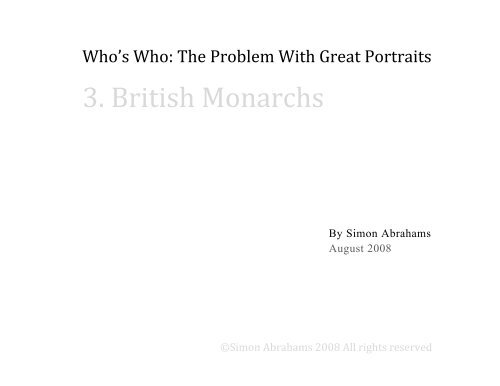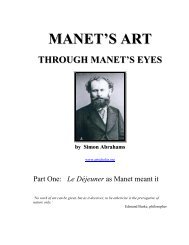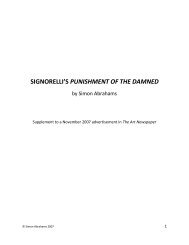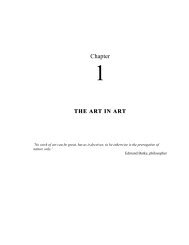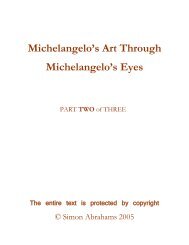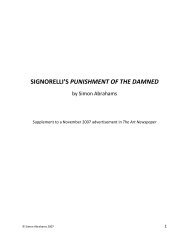3. British Monarchs - Every Painter Paints Himself
3. British Monarchs - Every Painter Paints Himself
3. British Monarchs - Every Painter Paints Himself
Create successful ePaper yourself
Turn your PDF publications into a flip-book with our unique Google optimized e-Paper software.
Who’s Who: The Problem With Great Portraits<br />
<strong>3.</strong> <strong>British</strong> <strong>Monarchs</strong><br />
By Simon Abrahams<br />
August 2008<br />
©Simon Abrahams 2008 All rights reserved
Later discovery, not included below. A contemporary, Francis Mortoft, saw the portrait in the<br />
gallery of the Grand Duke of Tuscany on 20 th December 1658 and thought it “nothing like<br />
him.”<br />
Crino and Millar, “Sir Peter Lely and the Grand Duke of Tuscany”, Burlington 100, April 1958, p.127<br />
The portraits that follow of Britain’s kings and queens are the visual<br />
icons of <strong>British</strong> history, the mnemonic markers of the island’s story.<br />
©Simon Abrahams 2008 2
Although they are neither the most important portraits in the history of<br />
art nor even the best examples of the poetry in question, they are<br />
nonetheless both widely known and of wide interest.<br />
Like the portraits in the preceding papers, these royal images were never<br />
intended by the artist as historical records of an actual sitter but as<br />
depictions of the artist’s alter ego. No doubt they pretended otherwise to<br />
their patrons but they and their peers knew better; the evidence is<br />
overwhelming. Of the many methods used to practice this deception, face<br />
fusion, for want of a better term, is the easiest to demonstrate. One or<br />
more of the artist’s features are fused with the sitter’s in such a way that<br />
the end-result can resemble both the sitter and the artist. Some are so<br />
like the artist, though, that the sitter’s own likeness is questionable.<br />
Pose, lighting and hairstyle are also used.<br />
Another of their tricks, linked to pose, is simple. By inverting or slightly<br />
rotating a face they were able to help disguise what they had done.<br />
Today, with computers, it is easy to reverse those changes as I have done<br />
in the comparisons below. A common hairstyle is another method,<br />
whether or not either person had such hair in reality.<br />
©Simon Abrahams 2008 3
Facial resemblance is not even needed in the practice of selfrepresentation<br />
because a single feature will do, as has been shown<br />
previously (Issue 2). However, to convince those new to this form of<br />
visual perception, I have limited the portraits to those that are obvious<br />
with the sole exception of Holbein’s. Some readers may want to improve<br />
their sight by checking their own observations of similarities against<br />
mine in the Appendix. With practice they will recognize these methods<br />
more easily.<br />
Holbein, one of the first artists to paint a <strong>British</strong> king with true illusion,<br />
was particularly subtle. His patron, after all, had few scruples and if<br />
Holbein had failed to capture the royal head as expected, his own might<br />
have been at stake. Whatever the reason, note how the following<br />
features in Henry VIII’s face match those in Holbein’s self-portrait: the<br />
line of the eyebrows, the curve of the nostril, a sharp contour running<br />
across the forehead, the turn of the head and the rectangular shape to<br />
their faces and beards. Most subtle is the similarity between their<br />
mouths, with Henry’s identical to the central portion of Holbein’s. At first<br />
sight, no-one would say they were the same; it requires close looking.<br />
©Simon Abrahams 2008 4
In Holbein’s portrait of the Prince of Wales, later Edward VI, the short<br />
eyebrows again match Holbein’s, just as the vertical stripes of Edward’s<br />
hair and headwear echo the artist’s hair. The rectangular face, a Holbein<br />
characteristic, is caught again in the bulging cheeks while the lips, like<br />
Henry’s, match the central portion of Holbein’s mouth, only much fuller.<br />
Finally, the edge of the nostril, shaped like a rectangular parenthesis,<br />
mimics Holbein’s too, only smaller.<br />
The other portraits illustrated here, fourteen more monarchs and a<br />
consort, need little explanation though, as mentioned, a list of<br />
similarities can be found in the appendix.<br />
©Simon Abrahams 2008 5
Henry VIII by Holbein Holbein by Holbein<br />
©Simon Abrahams 2008 6
Edward VI by Holbein Holbein by Holbein<br />
©Simon Abrahams 2008 7
Elizabeth I by Oliver Oliver by Oliver<br />
This miniature of Queen Elizabeth I was described by a leading scholar as<br />
“without doubt..painted from life” and “arguably our greatest likeness.”<br />
Yet the Queen, perhaps unhappy with the resemblance even so, is said to<br />
have disliked it. 1<br />
©Simon Abrahams 2008 8
Elizabeth I by Hilliard Hilliard by Hilliard<br />
©Simon Abrahams 2008 9
Charles I by Mijtens Mijtens by Mijtens<br />
©Simon Abrahams 2008 10
Charles I by Van Dyck Van Dyck by Van Dyck<br />
Note how the color of the king’s hair changes to match the artist’s: dark<br />
brown in Mijtens’ portrait (opposite), red in Van Dyck’s (above).<br />
©Simon Abrahams 2008 11
Charles II by Kneller Kneller by Kneller<br />
©Simon Abrahams 2008 12
James II when Duke of York by Lely Lely by Lely 2<br />
At least two contemporaries of Peter Lely complained that the faces in<br />
his portraits resembled each other, one even suggesting that he was<br />
too fond of studying his own features. 3<br />
©Simon Abrahams 2008 13
James II by Kneller Kneller by Kneller*<br />
*While the nose and eyes here of James II as Duke of York resemble those in the above self-portrait, the mouth and chin are a better<br />
match with those in Kneller’s earliest extant self-portrait of around 1685.<br />
©Simon Abrahams 2008 14
Anne by Kneller Kneller by Kneller<br />
©Simon Abrahams 2008 15
William III by Kneller (Engraving) Kneller by Kneller<br />
©Simon Abrahams 2008 16
Mary II by Kneller (engraving) Kneller by Kneller<br />
©Simon Abrahams 2008 17
George I by Kneller Kneller by Kneller<br />
©Simon Abrahams 2008 18
George II by Kneller Kneller by Kneller<br />
A contemporary reported how a couple visiting Kneller’s studio had to ask<br />
which portrait was of their son. When they were gone, Kneller protested<br />
that the portrait was a good resemblance though “by God, man, I did put a<br />
little sense in his face, and now his friends do not know their fool again.” 4<br />
©Simon Abrahams 2008 19
George III by Reynolds Reynolds by Reynolds<br />
©Simon Abrahams 2008 20
Queen Charlotte by Gainsborough Gainsborough by Gainsborough<br />
*The quality of this reproduction will be improved as soon as possible.<br />
©Simon Abrahams 2008 21
©Simon Abrahams 2008 22
©Simon Abrahams 2008 23
George IV by Reynolds Reynolds by Reynolds<br />
©Simon Abrahams 2008 24
Queen Victoria, Engraving after by Hayter* Hayter by Hayter<br />
*The quality of this reproduction will be improved as soon as possible.<br />
©Simon Abrahams 2008 25
Edward VII by Luke Fildes Luke Fildes by Luke Fildes<br />
©Simon Abrahams 2008 26
Elizabeth II by Annigoni Annigoni by Annigoni<br />
©Simon Abrahams 2008 27
Elizabeth II by Freud Freud by Freud<br />
©Simon Abrahams 2008 28
Lucian Freud, the only artist illustrated here still alive, has practiced selfrepresentation<br />
throughout his career. Note how in his self-portrait his hair<br />
resembles the shape of the diamond-encrusted cross in the Queen’s Crown and<br />
is colored silvery-grey too.<br />
In the next issue the focus turns to Italy and the Italian Renaissance. The<br />
examples, some of which can already be seen in the website’s Gallery, will<br />
make clear that artists in Britain were not working in a vacuum but had used<br />
their powers of visual perception to unveil the poetic content of earlier art<br />
elsewhere. Indeed behind their poetry lies a philosophy that many artists<br />
(painters and sculptors) must have learnt almost entirely through vision. What<br />
it is and how they did it remains to be explained but, first, viewers need to<br />
accept that the traditional understanding of art is deeply flawed. Only then will<br />
new ways of looking be welcomed.<br />
©Simon Abrahams 2008 29
APPENDIX (page number in parentheses)<br />
Holbein / Henry VIII (6)<br />
Eyebrows; line of nose is the same until Holbein’s extends outwards; nostril<br />
is the same shape, just smaller; central part of Holbein’s mouth equals the<br />
whole of the King’s; rectangular beard; sharp line curves across forehead<br />
Holbein / Edward VI (7)<br />
Striped hair/hat; curved contour across forehead; inner eyebrows;<br />
rectangular<br />
shape to face/beard<br />
Oliver/ Elizabeth I (8)<br />
Nose; eye openings; mouth; chin; facial shape<br />
Hilliard / Elizabeth I (9)<br />
Left contour and facial shape..same position of head; eyebrows lines similar,<br />
just thicker; curly hair; line of nose continuing up to eyebrow; narrow eyelid<br />
on right<br />
©Simon Abrahams 2008 30
Oliver’s and Hilliard’s versions of Elizabeth I have a different length to the<br />
chin, different shape to the eyes, different lips….<br />
Mytens / Charles I (10)<br />
The line of Charles’ nose is longer and less straight than the artist’s but ends<br />
in a similar bump with a similar nostril; lips; eye openings; a few loose<br />
strands above the left temple; similar parting; beard and moustache<br />
Van Dyck / Charles I (11)<br />
Unkempt hair; lines of both noses (excluding end); nostrils; lower lips; broad<br />
plane from center of near eyebrow to cheekbone; chin seems to be similar;<br />
diagonal line of collar.<br />
Van Dyck’s and Mytens’ portraits of Charles I have different color beards<br />
and moustaches though, in each case, they match the artist’s.<br />
Kneller / Charles II (12)<br />
Eyes; broad eyelids; long nose; lower lip<br />
Lely / James II when Duke of York (13)<br />
Hairstyle with two curls on forehead; heavy eyebrows; eye openings; straight<br />
nose though of different length<br />
©Simon Abrahams 2008 31
Kneller / James II (14)<br />
Hairstyle; eyebrows; shape of nose if not the length; lower lip and shape of<br />
upper lip<br />
Kneller / Anne (15)<br />
High, messy hair; loose curl above left eye; mouth that also curls up at the<br />
edges; chin<br />
Kneller / William III (16)<br />
Curly hair if not as curly; long nose though not as hooked; straight eyebrows;<br />
similarity to eyes though not identical; mouth; chin<br />
Kneller / Mary II (17)<br />
Eyebrows; shape of eyes with narrower eyelids; nose; mouth; facial shape<br />
Kneller / George I (18)<br />
Shape of hair; eyes; angle of nose; mouth though upper lip narrower; chin;<br />
facial shape<br />
Kneller / George II (19)<br />
Hair; eyebrows; eyes; angle of nose; shape of mouth though upper lip less<br />
full; chin<br />
©Simon Abrahams 2008 32
Reynolds / George III (20)<br />
Facial shape; contour of hair; eyebrows; eye openings; nose similar (except<br />
nostril); upper lip same; cleft in chin; tubular neck<br />
Gainsborough / Queen Charlotte (21)<br />
Eyebrows; eyes; mouth; chin; facial shape<br />
Reynolds / King George IV (22)<br />
Flying hair including a loose lock by the cheekbone; eyebrows; eye openings;<br />
line of nose with similar nostril; slightly open mouth; cleft chin<br />
Hayter / Queen Victoria (23)<br />
Eyebrows; far eye; line of nose; full lower lip; chin<br />
Luke Fildes / King Edward VII (24)<br />
Similar baldness; line of eyebrows; eye openings; nostril; beard and<br />
moustache<br />
Annigoni / Queen Elizabeth II (25)<br />
Shape of artist’s beret matches shape of Queen’s hair; raised eyebrows; angle<br />
of nose; mouth with full lower lip; shape of chin<br />
©Simon Abrahams 2008 33
Freud / Queen Elizabeth II (26)<br />
Hair color; eyebrows with frown; shape of eye opening on left with drooping<br />
eyelid on right; the dip in upper lip almost splits it in two; chin<br />
NOTES<br />
1 Strong, Artists of the Tudor Court: The Portrait Miniatures Rediscovered 1520‐1620 (London: V&A Museum) 1983, pp. 97, 124‐5<br />
2 The faces are even more alike when Lely’s self‐portrait here is compared to an unfinished head of James II by Lely in The National Portrait Gallery.<br />
3 Oliver Millar, Sir Peter Lely, 1618‐1680 (London: National Portrait Gallery) 1978, p. 25<br />
4 Jonathan Richardson, cited in J.D. Stewart, Sir Godfrey Kneller (London: National Portrait Gallery) 1971, p. 8.<br />
©Simon Abrahams 2008 34


